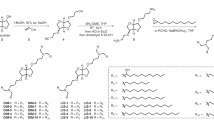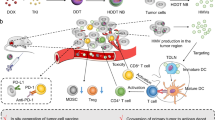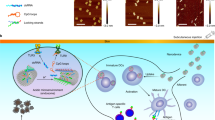Abstract
Dendritic cell-based cancer immunotherapy requires tumour antigens to be delivered efficiently into dendritic cells and their migration to be monitored in vivo. Nanoparticles have been explored as carriers for antigen delivery, but applications have been limited by the toxicity of the solvents used to make nanoparticles, and by the need to use transfection agents to deliver nanoparticles into cells. Here we show that an iron oxide–zinc oxide core–shell nanoparticle can deliver carcinoembryonic antigen into dendritic cells while simultaneously acting as an imaging agent. The nanoparticle–antigen complex is efficiently taken up by dendritic cells within one hour and can be detected in vitro by confocal microscopy and in vivo by magnetic resonance imaging. Mice immunized with dendritic cells containing the nanoparticle–antigen complex showed enhanced tumour antigen specific T-cell responses, delayed tumour growth and better survival than controls.
This is a preview of subscription content, access via your institution
Access options
Subscribe to this journal
Receive 12 print issues and online access
$259.00 per year
only $21.58 per issue
Buy this article
- Purchase on Springer Link
- Instant access to full article PDF
Prices may be subject to local taxes which are calculated during checkout






Similar content being viewed by others
References
Seong, S. Y. & Matzinger, P. Hydrophobicity: an ancient damage-associated molecular pattern that initiates innate immune responses. Nature Rev. Immunol. 4, 469–478 (2004).
Palucka, A. K., Ueno, H., Fay, J. W. & Banchereau, J. Taming cancer by inducing immunity via dendritic cells. Immunol. Rev. 220, 129–150 (2007).
Melief, C. J. Cancer immunotherapy by dendritic cells. Immunity 29, 372–383 (2008).
Bae, M. Y., Cho, N. H. & Seong, S. Y. Protective anti-tumour immune responses by murine dendritic cells pulsed with recombinant Tat-carcinoembryonic antigen derived from Escherichia coli. Clin. Exp. Immunol. 157, 128–138 (2009).
Figdor, C. G., de Vries, I. J., Lesterhuis, W. J. & Melief, C. J. Dendritic cell immunotherapy: mapping the way. Nature Med. 10, 475–480 (2004).
De Vries, I. J. et al. Effective migration of antigen-pulsed dendritic cells to lymph nodes in melanoma patients is determined by their maturation state. Cancer Res. 63, 12–17 (2003).
Prince, H. M. et al. In vivo tracking of dendritic cells in patients with multiple myeloma. J. Immunother. 31, 166–179 (2008).
de Vries, I. J. et al. Magnetic resonance tracking of dendritic cells in melanoma patients for monitoring of cellular therapy. Nature Biotechnol. 23, 1407–1413 (2005).
Dekaban, G. A. et al. Semiquantitation of mouse dendritic cell migration in vivo using cellular MRI. J. Immunother. 32, 240–251 (2009).
Bulte, J. W. In vivo MRI cell tracking: clinical studies. Am. J. Roentgenol. 193, 314–325 (2009).
Rogers, W. J., Meyer, C. H. & Kramer, C. M. Technology insight: in vivo cell tracking by use of MRI. Nature Clin. Practice 3, 554–562 (2006).
Martin, A. L., Bernas, L. M., Rutt, B. K., Foster, P. J. & Gillies, E. R. Enhanced cell uptake of superparamagnetic iron oxide nanoparticles functionalized with dendritic guanidines. Bioconjug. Chem. 19, 2375–2384 (2008).
Sun, R. et al. Physical and biological characterization of superparamagnetic iron oxide- and ultrasmall superparamagnetic iron oxide-labeled cells: a comparison. Invest. Radiol. 40, 504–513 (2005).
Kunzmann, A. et al. Efficient internalization of silica-coated iron oxide nanoparticles of different sizes by primary human macrophages and dendritic cells. Toxicol. Appl. Pharmacol. 253, 81–93 (2011).
Chen, C. L. et al. A new nano-sized iron oxide particle with high sensitivity for cellular magnetic resonance imaging. Mol. Imag. Biol. http://dx.doi.org/10.1007/s11307-010-0430-x (2010).
Gilboa, E. DC-based cancer vaccines. J. Clin. Invest. 117, 1195–1203 (2007).
Nel, A. E. et al. Understanding biophysicochemical interactions at the nano–bio interface. Nature Mater. 8, 543–557 (2009).
Sanvicens, N. & Marco, M. P. Multifunctional nanoparticles—properties and prospects for their use in human medicine. Trends Biotechnol. 26, 425–433 (2008).
Sun, C., Lee, J. S. & Zhang, M. Magnetic nanoparticles in MR imaging and drug delivery. Adv. Drug Deliv. Rev. 60, 1252–1265 (2008).
Klippstein, R. & Pozo, D. Nanotechnology-based manipulation of dendritic cells for enhanced immunotherapy strategies. Nanomedicine 6, 523–529 (2010).
Cruz, L. J. et al. Multimodal imaging of nanovaccine carriers targeted to human dendritic cells. Mol. Pharm. 8, 520–531 (2011).
Mackay, P. S. et al. Multimodal imaging of dendritic cells using a novel hybrid magneto-optical nanoprobe. Nanomedicine 7, 489–496 (2011).
Lim, Y. T. et al. Biocompatible polymer-nanoparticle-based bimodal imaging contrast agents for the labeling and tracking of dendritic cells. Small 4, 1640–1645 (2008).
Chang, E., Thekkek, N., Yu, W. W., Colvin, V. L. & Drezek, R. Evaluation of quantum dot cytotoxicity based on intracellular uptake. Small 2, 1412–1417 (2006).
Zhang, Z. et al. Induction of anti-tumor cytotoxic T cell responses through PLGA-nanoparticle mediated antigen delivery. Biomaterials 32, 3666–3678 (2011).
Noh, Y. W., Jang, Y. S., Ahn, K. J., Lim, Y. T. & Chung, B. H. Simultaneous in vivo tracking of dendritic cells and priming of an antigen-specific immune response. Biomaterials 32, 6254–6263 (2011).
Bilati, U., Allemann, E. & Doelker, E. Nanoprecipitation versus emulsion-based techniques for the encapsulation of proteins into biodegradable nanoparticles and process-related stability issues. AAPS PharmSciTech 6, E594–E604 (2005).
Stivaktakis, N. et al. PLA and PLGA microspheres of beta-galactosidase: effect of formulation factors on protein antigenicity and immunogenicity. J. Biomed. Mater. Res. A 70, 139–148 (2004).
Blank, F. et al. Biomedical nanoparticles modulate specific CD4(+) T cell stimulation by inhibition of antigen processing in dendritic cells. Nanotoxicology http://dx.doi.org/10.3109/17435390.2010.5141293 (2011).
Wang, D., Rayani, S. & Marshall, J. L. Carcinoembryonic antigen as a vaccine target. Exp. Rev. Vaccines 7, 987–993 (2008).
Bhattacharya-Chatterjee, M., Saha, A., Foon, K. A. & Chatterjee, S. K. Carcinoembryonic antigen transgenic mouse models for immunotherapy and development of cancer vaccines. Curr. Protoc. Immunol. 20, Unit 20 28 (2008).
Liu, H. L., Sonn, C. H., Wu, J. H., Lee, K. M. & Kim, Y. K. Synthesis of streptavidin-FITC-conjugated core–shell Fe3O4–Au nanocrystals and their application for the purification of CD4+ lymphocytes. Biomaterials 29, 4003–4011 (2008).
Millers, D., Grigorjeva, L., Lojkowski, W. & Strachowski, T. Luminescence of ZnO nanopowders. Radiat. Meas. 38, 589–591 (2004).
Wu, Y. L., Tok, A. I. Y., Boey, F. Y. C., Zeng, X. T. & Zhang, X. H. Chemical synthesis of ZnO nanocrystals. IEEE Trans. Nanotechnol. 6, 497–503 (2006).
Dong, L. et al. Preparation of ZnO colloids by aggregation of the nanocrystal subunits. J. Colloid Interface Sci. 283, 380–384 (2005).
Sarikaya, M., Tamerler, C., Schwartz, D. T. & Baneyx, F. O. Materials assembly and formation using engineered polypeptides. Annu. Rev. Mater. Res. 34, 373–408 (2004).
Kjaergaard, K., Sorensen, J. K., Schembri, M. A. & Klemm, P. Sequestration of zinc oxide by fimbrial designer chelators. Appl. Environ. Microbiol. 66, 10–14 (2000).
Thai, C. K. et al. Identification and characterization of Cu(2)O- and ZnO-binding polypeptides by Escherichia coli cell surface display: toward an understanding of metal oxide binding. Biotechnol. Bioeng. 87, 129–137 (2004).
Seker, U. O. & Demir, H. V. Material binding peptides for nanotechnology. Molecules 16, 1426–1451 (2011).
Xia, T. et al. Comparison of the mechanism of toxicity of zinc oxide and cerium oxide nanoparticles based on dissolution and oxidative stress properties. ACS Nano 2, 2121–2134 (2008).
Mailander, V. & Landfester, K. Interaction of nanoparticles with cells. Biomacromolecules 10, 2379–2400 (2009).
Baumjohann, D. et al. In vivo magnetic resonance imaging of dendritic cell migration into the draining lymph nodes of mice. Eur. J. Immunol. 36, 2544–2555 (2006).
Raynal, I. et al. Macrophage endocytosis of superparamagnetic iron oxide nanoparticles: mechanisms and comparison of ferumoxides and ferumoxtran-10. Invest. Radiol. 39, 56–63 (2004).
Fu, Y. S. et al. Stable aqueous dispersion of ZnO quantum dots with strong blue emission via simple solution route. J. Am. Chem. Soc. 129, 16029–16033 (2007).
Sallusto, F., Cella, M., Danieli, C. & Lanzavecchia, A. Dendritic cells use macropinocytosis and the mannose receptor to concentrate macromolecules in the major histocompatibility complex class II compartment: downregulation by cytokines and bacterial products. J. Exp. Med. 182, 389–400 (1995).
Long, C. M., van Laarhoven, H. W., Bulte, J. W. & Levitsky, H. I. Magnetovaccination as a novel method to assess and quantify dendritic cell tumor antigen capture and delivery to lymph nodes. Cancer Res. 69, 3180–3187 (2009).
Saha, A. et al. Dendritic cells pulsed with an anti-idiotype antibody mimicking carcinoembryonic antigen (CEA) can reverse immunological tolerance to CEA and induce antitumor immunity in CEA transgenic mice. Cancer Res. 64, 4995–5003 (2004).
Schneider, T. D. & Stephens, R. M. Sequence logos: a new way to display consensus sequences. Nucleic Acids Res. 18, 6097–6100 (1990).
Acknowledgements
This work was supported by the Pioneer Research Center Program through the National Research Foundation of Korea funded by the Ministry of Education, Science and Technology (2011-0001715). Y.K.K. was supported by the Leap Research Program through the National Research Foundation of Korea (2011-0016497) and the Industrial Core Technology Development Program funded by the Ministry of Knowledge Economy (10033183). S.Y.S. and N.H.C. were supported by a grant from the Innovative Research Institute of Cell Therapy funded by the Ministry of Health and Welfare (A062260). T.C.C. and J.H.M. were supported by Hi Seoul Science/Humanities Fellowship from Seoul Scholarship Foundation. The authors are grateful to N. Orazio for critical reading of the manuscript.
Author information
Authors and Affiliations
Contributions
N-H.C., S-Y.S. and Y.K.K. conceived and designed the experiments. T-C.C., J.H.M., J.H.W., S.J.L., D.H.K., J-S.Y. and S.K. performed the experiments. N-H.C., S-Y.S. and Y.K.K. analysed the data and wrote the paper. All authors discussed the results and commented on the manuscript.
Corresponding authors
Ethics declarations
Competing interests
The authors declare no competing financial interests.
Supplementary information
Supplementary information
Supplementary information (PDF 880 kb)
Rights and permissions
About this article
Cite this article
Cho, NH., Cheong, TC., Min, J. et al. A multifunctional core–shell nanoparticle for dendritic cell-based cancer immunotherapy. Nature Nanotech 6, 675–682 (2011). https://doi.org/10.1038/nnano.2011.149
Received:
Accepted:
Published:
Issue Date:
DOI: https://doi.org/10.1038/nnano.2011.149
This article is cited by
-
Green magnetic nanoparticles: a comprehensive review of recent progress in biomedical and environmental applications
Journal of Materials Science (2024)
-
An updated landscape on nanotechnology-based drug delivery, immunotherapy, vaccinations, imaging, and biomarker detections for cancers: recent trends and future directions with clinical success
Discover Nano (2023)
-
Effect of various morphologies and dopants on piezoelectric and detection properties of ZnO at the nanoscale: a review
Journal of Materials Science (2023)
-
Advancement and Applications of Nanotherapy for Cancer Immune Microenvironment
Current Medical Science (2023)
-
Engineering magnetic nano-manipulators for boosting cancer immunotherapy
Journal of Nanobiotechnology (2022)



